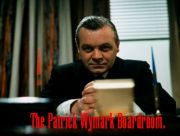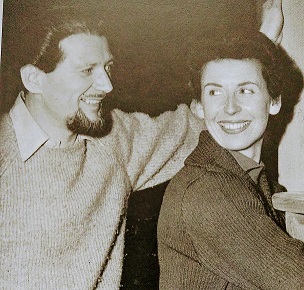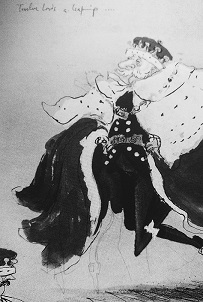
WENDY TOYE - Director The Soldiers' Tale, On The Twelfth Day, Three Cases of Murder, The Stranger Left No Card
Wendy Toye, who directed Patrick Wymark in The Soldiers Tale had a career spanning dance, stage, film and TV
Wendy Toye, who was born May 1st 1917, was a child star as a dancer, later a member of Ninette de Valois' original Vic-Wells ballet, principal dancer in The Golden Toy (Coliseum)aged 17. but was forced to give up ballet after an appendix operation and moved on to choreography. She came up with the dance moves for the Kali doll in Korda's The Thief of Bagdad (1940) as well as many other films and stage shows. During the war she volunteered to stage Soldiers In Skirts a show for visiting US Servicemen and this created a lasting friendship with the organiser, actor/producer George K Arthur. In 1946, impresario C.B. Cochrane (who had known Toye since she had won an amateur Charleston dance competition as a child) , offered her the chance to direct the stage musical Big Ben. This was a success, but in June 1947 Toye was invited to return to performing when she joined the first West End production of Annie Get Your Gun at the London Coliseum as Winnie Tate (a character written out of the film version). She then travelled to Broadway where she co-directed (with John Burrell) the 1950 production of Peter Pan starring Jean Arthur and Boris Karloff with music and lyrics by Leonard Bernstein.
While in America, she became reacquainted with George K Arthur who had the rights to a story by Sidney Carroll (The Hustler (1961), Gambit (1966) ) called The Stranger Left No Card. Toye made various suggestions on British production personnel, including casting Alan Badel in the lead. This resulted in Arthur asking Toye to direct the film.
The Stranger Left No Card (1952) was filmed in Windsor and stars Badel as an eccentric magician who arrives in town one morning and quickly establishes a reputation for outrageous behaviour. As William Fowler notes*, cameraman Jonah Jones, "keeping the dandy tight centre frame wilst still taking in selected details; faces buildings and other peculiarities. Nimbly following the coattails of Badel as he strode down old-timey cobbled streets."At first it appears to be a whimsical children's film, but the mood of the film changes as the twist at the heart of the tale results in a sinister conclusion. The film won an award at the 1953 Cannes Film Festival, described by Jean Cocteau as a masterpiece.
As a result of the success of the short film, Toye was put under contract by Alexander Korda who asked her to put together a portmanteau movie to showcase Alan Badel. Three Cases of Murder, was originally conceived with a framing sequence in which museum attendant Hugh Pryse guided visitors toward three exhibits which would lead into separate stories. Badel would appear in three separate roles: the supporting role of a barman in Brett Halliday's opening crime story 'You Killed Elizabeth', the co-starring role of a politician who enters the dreams of Somerset Maugham's 'Lord Montdrago' and the leading role of the supernatural Mr X in the concluding segment - Donald Wilson's adaptation of Roderick Wilkinson's 'In The Picture'. Toye had directed Hugh Pryce's framing sequence and 'In The Picture' when Korda announced that Orson Welles had agreed to star in the middle story - 'Lord Mountdrago'. The only problem was that Welles insisted his story should be the final one. This meant the framing sequence wouldn't work, because it had been filmed to conclude with 'In The Picture'. So, it was abandoned, and Toye filmed a new series of links with stolid TV personality Eamonn Andrews (This is Your Life) introducing the stories.
Hugh Pryce and Alan Badel in Three Cases of Murder
Toye's segment gives a taste of how the whole film might have played out if it had been screened with the original framing sequence. Hugh Pryse leads the tourists to, "the most intriguing work in the collection - a landscape by an unknown artist. As the tourists move on, he notices that the glass of the painting has been shattered - not for the first time - and is engaged in conversation by Mr X (Badel) who walks him towards the painting, debating whether the composition would be better balanced if the window of the house had a light in it. The camera follows the characters' movement over their shoulders as they walk into the painting and up the path to the entrance of the house. Inside the house, Badel introduces the attendant to his wife (Lueen Macgrath - The Saint's Vacation 1941) and a sinister taxidermist Mr Snyder (Eddie Byrne - Star Wars (1977)) who is visiting from another painting. Toye and cinematographer Georges Perinal quickly establish a bleak otherworldly mood within the painting.
The adaptation of 'Lord Mountdrago' was directed by the experienced George More O'Ferrall who later directed The Plane Makers episode 'The Island Game'. Welles is reputed to have treated O'Ferrall to his usual suggestions and 'taken over the directing' although it's hard to tell how much of this is true. Certainly Welles' the actor seems particularly exuberant in some of the dream sequences and does make a strong impression.
However, it's hard not to mourn the film that might have been, if Korda had stuck to the original plan. Certainly Three Cases of Murder might have had a better reputation as some kind of missing link between Dead Of Night and the Amicus movies such as Doctor Terrors House of Horrors. Also, poor Hugh Pryce, who died in 1955 might have had more of a place in film history. Ironically, Three Cases of Murder was not released until 1955, reputedly because the two main exhibition chains said Orson Welles was not a big enough name in the UK.

Ronald Searle and Wendy Toye and Wendy Toye and David O'Brien
In 1955, Toye again teamed up with George K. Arthur to make another short film On The Twelfth Day. This was born out of a collaboration with her friend St Trinians cartoonist Ronald Searle, following an abortive first attempt in 1952 to make a film called The Paper Chase with stories linked by a newspaper blowing down the street. On The Twelfth Day imagines what would happen if an ardent lover tried to put the gifts of the Twelve Days of Christmas into action. Set in a Christmas Card colour Edwardian street, the film stars Toye herself as Miss Tilly and dance and mime David O'Brien as Truelove. Photographed by Arthur Grant, " the entire production was colour co-ordinated by Searle in such a way as to put a gorgeous sheen of unreal decorative patterning on everything, including the animals. Searle expected his audience to make deductions from what they saw, hence the specification on the design for the Lords that 'one could have long pants or a nightshirt (overslept)'**

Although the film was entered into the Venice Film Festival, UK exhibitors were once again reluctant to pick up what was effectively a silent movie. However, Arthur sold the film to NBC in America for £15,000 (£400,000 in todays money) and they screened the film on New Year's Day 1956. Life magazine publishing a five page colour spread. Bosley Crowther of the New York Times called it "a glittering and witty little gem." and by Christmas of 1956 the short was being screened in UK cinemas. The film was subsequently sold to the BBC in 1958, being repeated on Christmas 1959 and 1961.
Searle and Toye also worked together on a stage play called Wild Thyme in 1955, and in 1963 collaborated once more on The Kings Breakfast a short financed by the Milk Marketing Board, about a King demanding butter for his toast. Among the cast were Warren Mitchell, Una Stubbs, Maurice Denham and Mischa Auer.
Following Korda's death, Toye's film contract was picked up by Rank along with All For Mary (1956) an adaptation of a stage comedy by Kay Bannerman and Harold Brooke which had a successful run at the Duke of York's Theatre in 1954. Three of the stars of the stage play - David Tomlinson, Neil Hallett and Kathleen Harrison as Tomlinson's former nanny - joined the film set in the then-exotic location of a Swiss alpine resort. During the same period she also directed stage plays such as Lady At The Wheel (1958) at the Lyric, Hammersmith and As You Like It (1959) at the Old Vic.
Toye, who said she "always felt that I was a bit of a guest in the film world." went on to direct The Teckmann Mystery (1954) starring John Justin in an adaptation of a Francis Durbridge TV serial (Toye's view in the 1990's was that the film was slow due to the 1950's conventions of showing a character walk out of the door and down the street rather than cutting between locations). Other films she was assigned included Raising a Riot (1955) starring Kenneth More as a naval officer who is forced to look after his three children when his wife has to fly to Canada and True As A Turtle (1957)- a kind of seaborne Genevieve - in which the female characters have to endure the spartan enthusiasms of the male leads. This time a seasick June Thorburn and Elvi Hale accompany John Gregson and Keith Michell on a jaunt to France aboard the Turtle - a sailing yacht borrowed from businessman Cecil Parker (Avice Landon from Blood On Satan's Claw appears as Parker's wife). A technically challenging film with a lot of location work, Toye reputedly had to defend one of the female leads after one of the producers took against her. Music is by Robert Farnon (Colditz, Secret Army) and coincidentally a character called Paul is played by Michael E. Briant, a 17 year-old actor who later became a BBC director for those two series (among many others).
It's hard not to imagine that a man who had been as multi-skilled as Toye would have been hailed as some kind of genius. Certainly she had plenty of other avenues to explore and no need to continue with film directing. Ironically, her last directing job was A Stranger In Town (1982) a remake of The Stranger Left No Card for Tales of the Unexpected (Anglia TV) starring Derek Jacobi.
* The Bodies Beneath by William Fowler and Vic Pratt includes a chapter on The Stranger Left No Card See more here.
** Ronald Searle, a Biography by Russell Davies - Sinclair-Stevenson Ltd 1990.
Details of Three Cases of Murder taken from Interview with Wendy Toye by Linda Wood and Dave Robson for the BECTU British Entertainment History Project https://historyproject.org.uk/interview/wendy-toye